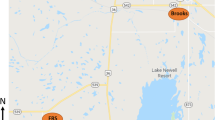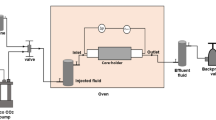Abstract
CO2 can be injected into deep saline aquifers for storage, thereby reducing the concentration of CO2 in the atmosphere. When CO2 is injected into the aquifer, salt precipitation may occur, which may impair the injectivity and affect storage safety. In this study, numerical simulation was used to study salt precipitation in heterogeneous anisotropic sandstone aquifers, the feedback effect of salt precipitation on the flow was considered, and the additional pressure increase caused by salt precipitation was evaluated. The results showed that the maximum decrease in formation permeability and the maximum additional pressure buildup caused by salt precipitation reached 88% and 4.91 MPa, respectively. The salinity of the formation water and the maximum additional pressure buildup is approximately proportional when the salinity is low. Once the salinity exceeds a certain value (approximately 20% in this study), the maximum additional pressure buildup increases sharply. As the permeability increases, the additional pressure buildup decreases. When permeability reaches a certain threshold (approximately 5×10−14 m2 in this study), the maximum additional pressure buildup decreases rapidly and changes only slightly as permeability increases. The CO2 injection rate is basically proportional to the maximum additional pressure buildup. When the vertical permeability increases, the additional pressure buildup due to salt precipitation shows a downward trend. The low-permeability interbeds above the CO2 injection well will cause more local salt precipitation near it, which will further cause a greater and wider pressure buildup. The heterogeneity of the formation will greatly enhance salt precipitation, thereby promoting the formation pressure buildup. The formation heterogeneity must be considered in the study of the salt precipitation and its effect on CO2 injection, especially when the formation permeability is low, the CO2 injection rate is high, and the salinity of the formation water is high.






















Similar content being viewed by others
Data availability
Not applicable.
References
Andre L, Peysson Y, Azaroual M (2014) Well injectivity during CO2 storage operations in deep saline aquifers - Part 2: numerical simulations of drying, salt deposit mechanisms and role of capillary forces. Int J Greenh Gas Control 22:301–312
Bacci G, Korre A, Durucan S (2011) Experimental investigation into salt precipitation during CO2 injection in saline aquifers. Energy Procedia 4:4450–4456
Bachu S, Adams JJ (2003) Sequestration of CO2 in geological media in response to climate change: capacity of deep saline aquifers to sequester CO2 in solution. Energy Convers Manag 44:3151–3175
Bachu S, Gunter WD, Perkins EH (1994) Aquifer disposal of CO2: hydrodynamic and mineral trapping. Energy Convers Manag 35:269–279
Baumann G, Henninges J, De Lucia M (2014) Monitoring of saturation changes and salt precipitation during CO2 injection using pulsed neutron-gamma logging at the Ketzin pilot site. Int J Greenh Gas Control 28:134–146
Berntsen A, Todorovic J, Raphaug M, Torsaeter M, Panduro EAC, Gawel K (2019) Salt clogging during supercritical CO2 injection into a downscaled borehole model. Int J Greenh Gas Control 86:201–210
Corey AT (1954) The interrelation between gas and oil relative permeabilities. Producers Mon. 19:38–41
Diao Y, Zhu G, Li X, Bai B, Li J, Wang Y, Zhao X, Zhang B (2020) Characterizing CO2 plume migration in multi-layer reservoirs with strong heterogeneity and low permeability using time-lapse 2D VSP technology and numerical simulation. Int J Greenh Gas Control 92:102880
Edem D, Abba M, Nourian A, Babaie M, Naeem Z (2020) Experimental investigation of the extent of the impact of halite precipitation on CO2 injection in deep saline aquifers, SPE Europec featured at 82nd EAGE Conference and Exhibition. Society of Petroleum Engineers, Amsterdam, p 14
Falcon-Suarez IH, Livo K, Callow B, Marin-Moreno H, Prasad M, Best AI (2020) Geophysical early warning of salt precipitation during geological carbon sequestration. Sci Rep 10:16472
Ghafoori M, Tabatabaei-Nejad SA, Khodapanah E (2017) Modeling rock-fluid interactions due to CO2 injection into sandstone and carbonate aquifer considering salt precipitation and chemical reactions. J Nat Gas Sci Eng 37:523–538
Giorgis T, Carpita M, Battistelli A (2007) 2D modeling of salt precipitation during the injection of dry CO2 in a depleted gas reservoir. Energy Convers Manag 48:1816–1826
Grude S, Landro M, Dvorkin J (2014) Pressure effects caused by CO2 injection in the Tubaen Fm., the Snohvit field. Int J Greenh Gas Control 27:178–187
Gunter WD, Perkins EH, McCann TJ (1993) Aquifer disposal of CO2-rich gases: reaction design for added capacity. Energy Convers Manag 34:941–948
Han WS, Stillman GA, Lu M, Lu CA, McPherson BJ, Park E (2010) Evaluation of potential nonisothermal processes and heat transport during CO2 sequestration. J Geophys Res Solid Earth 115:B07209
He D, Jiang P, Xu R (2019) Pore-scale experimental investigation of the effect of supercritical CO2 injection rate and surface wettability on salt precipitation. Environ Sci Technol 53:14744–14751
IPCC (ed) (2005) Carbon dioxide capture and storage. Cambridge University, Cambridge
Jayne RS, Zhang YQ, Pollyea RM (2019) Using Heat as a Predictor of CO2 Breakthrough in highly heterogeneous reservoirs. Geophys Res Lett 46:5879–5888
Jeddizahed J, Rostami B (2016) Experimental investigation of injectivity alteration due to salt precipitation during CO2 sequestration in saline aquifers. Adv Water Resour 96:23–33
Leverett MC (1941) Capillary behavior in porous solids. Trans 142:152–169
Lopez O, Youssef S, Estublier A, Alvestad J, Weierholt Strandli C (2020) Permeability alteration by salt precipitation: numerical and experimental investigation using X-Ray Radiography. E3S Web Conf 146:03001
Lu M, Connell LD (2008) Non-isothermal flow of carbon dioxide in injection wells during geological storage. Int J Greenh Gas Control 2:248–258
Matter JM, Stute M, Snaebjornsdottir SO, Oelkers EH, Gislason SR, Aradottir ES, Sigfusson B, Gunnarsson I, Sigurdardottir H, Gunnlaugsson E, Axelsson G, Alfredsson HA, Wolff-Boenisch D, Mesfin K, Taya DFD, Hall J, Dideriksen K, Broecker WS (2016) Rapid carbon mineralization for permanent disposal of anthropogenic carbon dioxide emissions. Science 352:1312–1314
McGrail BP, Schaef HT, Spane FA, Cliff JB, Qafoku O, Horner JA, Thompson CJ, Owen AT, Sullivan CE (2017) Field validation of supercritical co2 reactivity with basalts. Environ Sci Technol Lett 4:6–10
Michael K, Golab A, Shulakova V, Ennis-King J, Allinson G, Sharma S, Aiken T (2010) Geological storage of CO2 in saline aquifers—a review of the experience from existing storage operations. Int J Greenh Gas Control 4:659–667
Miri R, Hellevang H (2016) Salt precipitation during CO2 storage-a review. Int J Greenh Gas Control 51:136–147
Oldenburg CM (2007) Joule-Thomson cooling due to CO2 injection into natural gas reservoirs. Energy Convers Manag 48:1808–1815
Ott H, de Kloe K, Marcelis F, Makurat A (2011) Injection of supercritical CO2 in brine saturated sandstone: pattern formation during salt precipitation. In: Gale J, Hendriks C, Turkenberg W (eds) 10th International Conference on Greenhouse Gas Control Technologies. Energy Procedia. Elsevier Science Bv, Amsterdam, pp 4425–4432
Ott H, Roels SM, de Kloe K (2015) Salt precipitation due to supercritical gas injection: I. Capillary-driven flow in unimodal sandstone. Int J Greenh Gas Control 43:247–255
Pan L, Spycher N, Doughty C, Pruess K (2017) ECO2N V2.0: A TOUGH2 fluid property module for modeling CO2-H2O-NACL systems to elevated temperatures of up to 300 degrees C. Greenh Gases Sci Technol 7:313–327
Parvin S, Masoudi M, Sundal A, Miri R (2020): Continuum scale modelling of salt precipitation in the context of CO2 storage in saline aquifers with MRST compositional. Int J Greenh Gas Control 99:103075
Peysson Y, Andre L, Azaroual M (2014) Well injectivity during CO2 storage operations in deep saline aquifers-Part 1: experimental investigation of drying effects, salt precipitation and capillary forces. Int J Greenh Gas Control 22:291–300
Pruess K (2005): ECO2N: A TOUGH2 fluid property module for mixtures of water, NaCl, and CO2. Report LBNL-57592, Lawrence Berkeley National Laboratory, Berkeley, California
Pruess K, Muller N (2009) Formation dry-out from CO2 injection into saline aquifers: 1. Effects of solids precipitation and their mitigation. Water Resour Res 45:W03402
Pruess K, Spycher N (2006): ECO2N - A new TOUGH2 fluid property modes for studies of CO2 storage in saline aquifers. TOUGH Symposium 2006, Lawrence Berkeley Laboratory, Berkeley, California
Pruess K, Oldenburg C, Moridis G (2012) TOUGH2 user's guide, version 2. Report LBNL-43134. Lawrence Berkeley Laboratory, Berkeley, California
Ren J, Wang Y, Zhang Y (2018) A numerical simulation of a dry-out process for CO2 sequestration in heterogeneous deep saline aquifers. Greenh Gases Sci Technol 8:1090–1109
Roels SM, Ott H, Zitha PU (2014) μ-CT analysis and numerical simulation of drying effects of CO2 injection into brine-saturated porous media. Int J Greenh Gas Control 27:146–154
Van Genuchten MT (1980) A closed-form equation for predicting the hydraulic conductivity of unsaturated soils. Soil Sci Soc Am J 44:892–898
Verma A, Pruess K (1988) Thermohydrological conditions and silica redistribution near high-level nuclear wastes emplaced in saturated geological formations. J Geophys Res Solid Earth Planets 93:1159–1173
Wang Y, Wei N, Zhang CY, Wietsma TW, Bonneville A, Li XC, Li M, Wang ZM (2018): Experimental study of drying effects during supercritical CO2 displacement in a pore network. Microfluid Nanofluidics 22:101
Xu T, Apps JA, Pruess K (2004) Numerical simulation of CO2 disposal by mineral trapping in deep aquifers. Appl Geochem 19:917–936
Zeidouni M, Pooladi-Darvish M, Keith D (2009) Analytical solution to evaluate salt precipitation during CO2 injection in saline aquifers. Int J Greenh Gas Control 3:600–611
Zhang K, Xie J, Li C, Hu L, Wu X, Wang Y (2016) A full chain CCS demonstration project in northeast Ordos Basin, China: operational experience and challenges. Int J Greenh Gas Control 50:218–230
Zhao R, Cheng J (2017) Effects of temperature on salt precipitation due to formation dry-out during CO2 injection in saline aquifers. Greenh Gases Sci Technol 7:624–636
Zhao R, Cheng J, Zhang K (2012) CO2 plume evolution and pressure buildup of large-scale CO2 injection into saline aquifers in Sanzhao Depression, Songliao Basin, China. Transp Porous Media 95:407–424
Acknowledgements
Thanks are due to Keni Zhang for his guidance in the use of the software.
Funding
This study was supported by the Project of National Sciences Foundation of China (Nos. 41402212 and U1911205).
Author information
Authors and Affiliations
Contributions
Ruirui Zhao and Jianmei Cheng designed the methodology and set up the models. Ruirui Zhao analyzed the results and wrote the manuscript.
Corresponding author
Ethics declarations
Ethics approval and consent to participate
Not applicable.
Consent for publication
Not applicable.
Competing interests
The authors declare no competing interests.
Additional information
Responsible Editor: Philippe Garrigues
Publisher’s note
Springer Nature remains neutral with regard to jurisdictional claims in published maps and institutional affiliations.
Rights and permissions
About this article
Cite this article
Zhao, ., Cheng, J. Salt precipitation and associated pressure buildup during CO2 storage in heterogeneous anisotropy aquifers. Environ Sci Pollut Res 29, 8650–8664 (2022). https://doi.org/10.1007/s11356-021-16322-y
Received:
Accepted:
Published:
Issue Date:
DOI: https://doi.org/10.1007/s11356-021-16322-y




